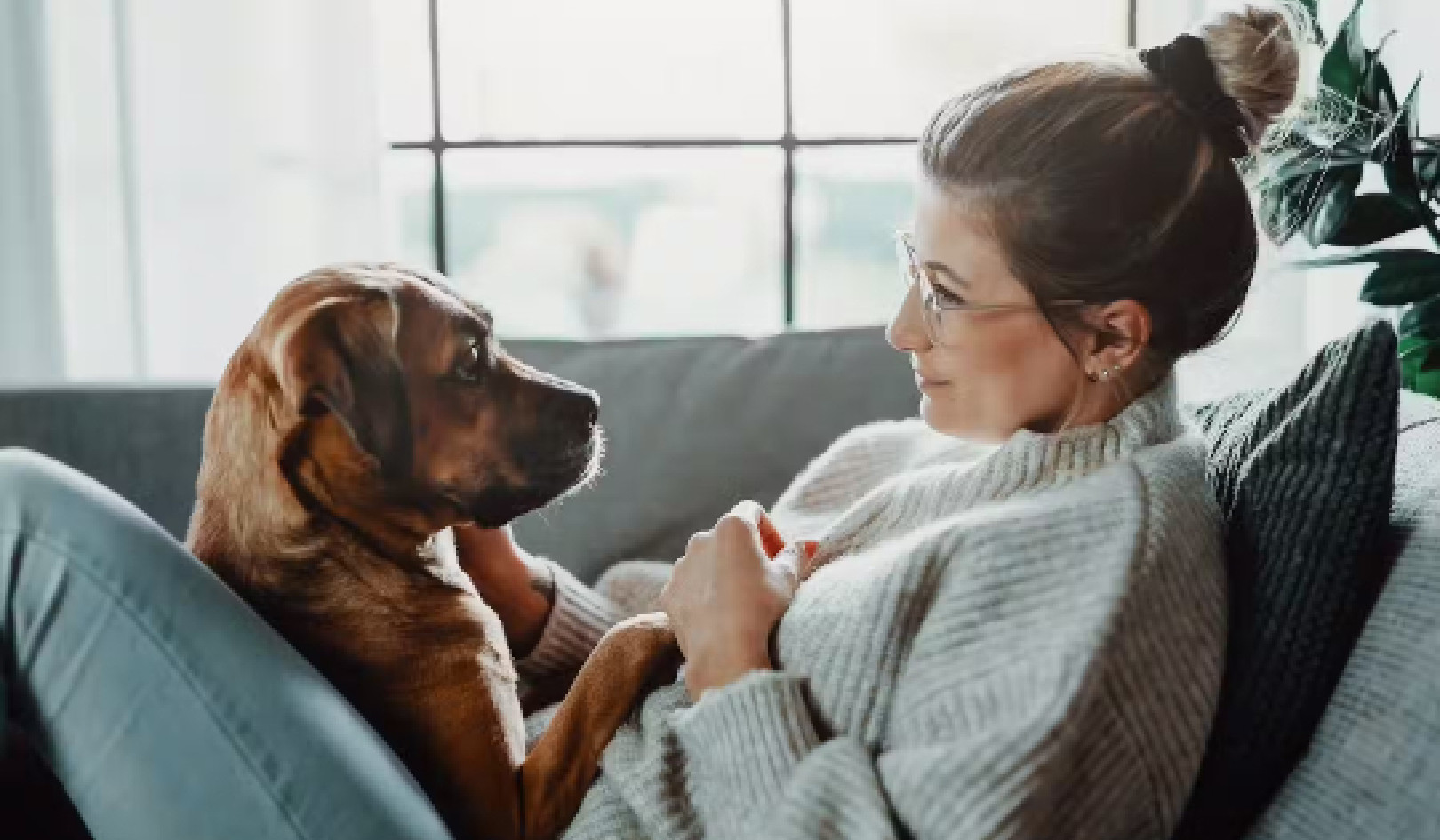
Image by Annemieke Weverbergh
When considering end-of-life issues for pets, it is important to always keep in mind the question, “What is best for this animal?” This applies whether the pet is terminally ill, severely injured, deteriorating due to old age, or suffering from behavioural problems for which no appropriate solution has been found.
Understandably, it is incredibly difficult to lose an otherwise healthy pet due to behavioural problems, but knowing that you explored all options and sought professional advice before agreeing to euthanasia can offer some reassurance during this stressful time. It may help to remember that securing a compassionate death can be a final act of kindness, however difficult it is for those left behind.
Finding the Right Time to Say Goodbye to Your Pet
Trying to decide when to have a much-loved companion animal put to sleep can present a myriad of uncertainties. Because of the emotional and mental turmoil, it can be difficult to quieten your mind and listen to your instinct. On the one hand, you want whatever is best for your pet; on the other, this is an irrevocable decision.
You may worry about having your pet put to sleep too soon and, therefore, depriving them of time. Or you may be anxious to ensure that they don’t get to a stage when they start to suffer. The thing to remember is that you don’t have to work this out totally on your own. While the final decision has to be made by you, the vet professionals are there to offer vital information and guidance.
One way of thinking about when to consider euthanasia is that it is preventing suffering rather than ending suffering.
The Quandary: Too Soon or Too Late?
I remember a few years ago going through this myself with an elderly guinea pig. Beryl had been a wonderful companion who had played a crucial role in educational sessions for a school programme called “Being Kind to Animals”, before retiring at around four or five years of age. When she reached the grand age of eight years, which is good going for a guinea pig, I noticed some changes in her demeanour and body condition that made me think she wasn’t feeling as well as normal.
I was determined that this little life wasn’t going to suffer unnecessarily, and am firmly of the mind that a little too soon is definitely better than a little too late. So I took her to the vet for a checkup and asked outright whether I needed to consider having her put to sleep in the near future. I explained that I was anxious to ensure that she didn’t suffer; she’d had as comfortable a life as I could offer her, and I wanted to ensure that she had a comfortable death.
The vet gave her a thorough examination and reassured me that she was in good health and would probably go on for another year! She also told me what to look out for that would indicate that Beryl was losing condition.
I was pleased and relieved and arranged to take her every six months for an assessment, or sooner if I had any concerns. A year later, Beryl’s condition suddenly deteriorated, and despite the fact that she kept eating, I knew that it was time for her to be gently put to sleep. The vet agreed, and I said my goodbye to this beloved guinea pig who had reached the grand age of nine.
My point in sharing this story is to show that rather than inwardly fretting and worrying, I discussed my concerns with the vet and got professional guidance and information, then, having been reassured, I was able to enjoy the time we had left together.
Getting Help to Make the Right Decision
Here’s another story to help illustrate how a friend worked out the best time to say goodbye to her beloved cat.
My friend’s cat, Silver, became suddenly ill, and after consulting the vet and exploring all the options, she knew that the kindest thing was to arrange for him to be put to sleep. She was then faced with the difficulty of working out the right time, as although it was clearly imminent it wasn’t quite the right time at that point.
To reduce stress for her cat, she wanted a home visit for the euthanasia and, ideally, this would be with her usual vet. Originally, she booked the appointment for the Friday, but as the day dawned, she knew that it was a little too soon. It became clear that the time to say goodbye to Silver seemed likely to fall on the weekend. When she cancelled the Friday appointment she was told that her vet could come out on the Saturday, but if it was Sunday, it would mean taking him to an emergency service, which was likely to be really stressful, especially as it would be a vet neither she nor Silver knew.
After thinking things through and weighing the pros and cons, my friend made the difficult decision to rebook the euthanasia visit at home on Saturday. Although it might be a day early, she felt it was more important to keep her cherished cat as calm and peaceful as possible, which she could only do at home. She didn’t want to risk the potential additional stress of taking him into a vet hospital on the Sunday or keeping him alive until the Monday if he was suffering.
Afterwards, she reflected to me that she felt okay about the timing of Silver’s euthanasia because the most important thing was to make his passing as calm as possible.
There is no doubt that it is incredibly difficult to be objective about your pet’s quality of life when emotions are running wild; therefore, a methodical system to gather information will help you stay grounded and be realistic. Keeping a diary of your pet’s general condition and behaviour will enable you to keep track of any changes that may not be obvious when you see them every day.
Recognizing Important Changes in Your Pet’s Well-being
This next activity is to help you to work out a system to recognize important changes as they occur and know what to do about them.
Ask your vet for guidance on how to measure changes in your pet’s well-being. The list below offers suggestions, but it will depend on the type of animal and what you and your vet decide about your particular pet’s needs. Leave space beside each point to write down what to do:
What to Look Out For
Behaving differently, such as:
Having out-of-character reactions, such as aggression
Being listless
Avoiding people or hiding
Being disoriented or confused
Are they:
Losing weight?
Off their food?
Questions to ask yourself:
Should I take a photo each week to notice gradual changes?
Does their fur or feathers look any different?
Have they got any new lumps or bumps?
Are they struggling to stand up or lie down, or finding it difficult to walk or move about?
Are they coughing or being sick?
Are they crying, moaning or breathing heavily and/or quickly?
When would I need to contact the vet urgently?
There may be other things which you or your vet could add to this list.
This focused and practical approach should give you some peace of mind, as you are more likely to recognize a gradual or sudden worsening of your pet’s condition and will know what to do about it.
In addition, you’ll need the following information written down:
Normal opening times of the surgery
Out-of-hours contact details for your vet
Cost of an emergency call-out
Some Pets Hide Their Illness
Some types of pets will naturally try to hide any signs of illness or weakness, making it much more difficult to notice when something isn’t right. Whilst my pet dog will look at me with his paw raised because he has hurt his leg and wants some help, it was a different story when I cared for birds. Generally my budgies, cockatiels, and parrot only showed signs of illness when the disease or condition had advanced and they were no longer able to hide it, by which time they were already very sick. Such masking of weakness comes from an ingrained survival instinct in species that could become easy pickings for potential predators in the wild.
People who look after birds are usually aware of this and keep a keen eye on their feathered charges. It’s not just birds that do this; many types of animal have a similar survival mechanism. For example, donkeys have an incredibly stoical nature, and early signs of illness are difficult to notice because they don’t show it in the same way as other equines.
Despite keeping a close eye on my beloved avian companions, I discovered that they were very good at hiding the fact that they were unwell. When my parrot became ill, the only thing I noticed was that her breathing seemed faster. Within hours, this had advanced to her breathing being slightly laboured. Despite prompt treatment from a visiting vet at home, and then being treated in the vet hospital, sadly she didn’t make it.
On reflection, I realized that there was absolutely no point in giving myself a hard time because I and the avian vet had done everything we could to save her within that short time span, and I had to accept that this is what can happen with feathered friends.
Copyright ©2021. All Rights Reserved.
Adapted with permission of the publisher,
Findhorn Press, an imprint of Inner Traditions Intl.
Article Source:
BOOK: When It's Time to Say Goodbye
When It's Time to Say Goodbye: Preparing for the Transition of Your Beloved Pet
by Angela Garner Our pets are members of our families. The death or separation from a beloved animal friend--whether anticipated or unexpected--can unleash a roller coaster of emotions. In this compassionate guide based on 20 years' experience helping individuals and teaching veterinary professionals, Angela Garner offers practical support and guidance to help you prepare for your pet’s death ahead of time, do your best by your animal friend when the time comes, and work through your grieving process afterward.
Our pets are members of our families. The death or separation from a beloved animal friend--whether anticipated or unexpected--can unleash a roller coaster of emotions. In this compassionate guide based on 20 years' experience helping individuals and teaching veterinary professionals, Angela Garner offers practical support and guidance to help you prepare for your pet’s death ahead of time, do your best by your animal friend when the time comes, and work through your grieving process afterward.
Click here for more info and/or to order this paperback book. Also available as a Kindle edition.
About the Author
 Angela Garner is an animal bereavement specialist and former nurse. During 30 years in human healthcare as a Registered General Nurse, Angela developed a strong interest in end-of-life issues and communicating with the dying and bereaved with empathy and sensitivity. With a life-long passion for animal welfare, it was a natural progression to study and specialize in Companion Animal Bereavement Support.
Angela Garner is an animal bereavement specialist and former nurse. During 30 years in human healthcare as a Registered General Nurse, Angela developed a strong interest in end-of-life issues and communicating with the dying and bereaved with empathy and sensitivity. With a life-long passion for animal welfare, it was a natural progression to study and specialize in Companion Animal Bereavement Support.
She founded a national support service in the UK to help people through the grieving process, developing a wide range of pet bereavement support resources She was awarded a fellowship by the Society of Bereavement Practitioners for her work.
Visit her website: PetLossPress.com/



























